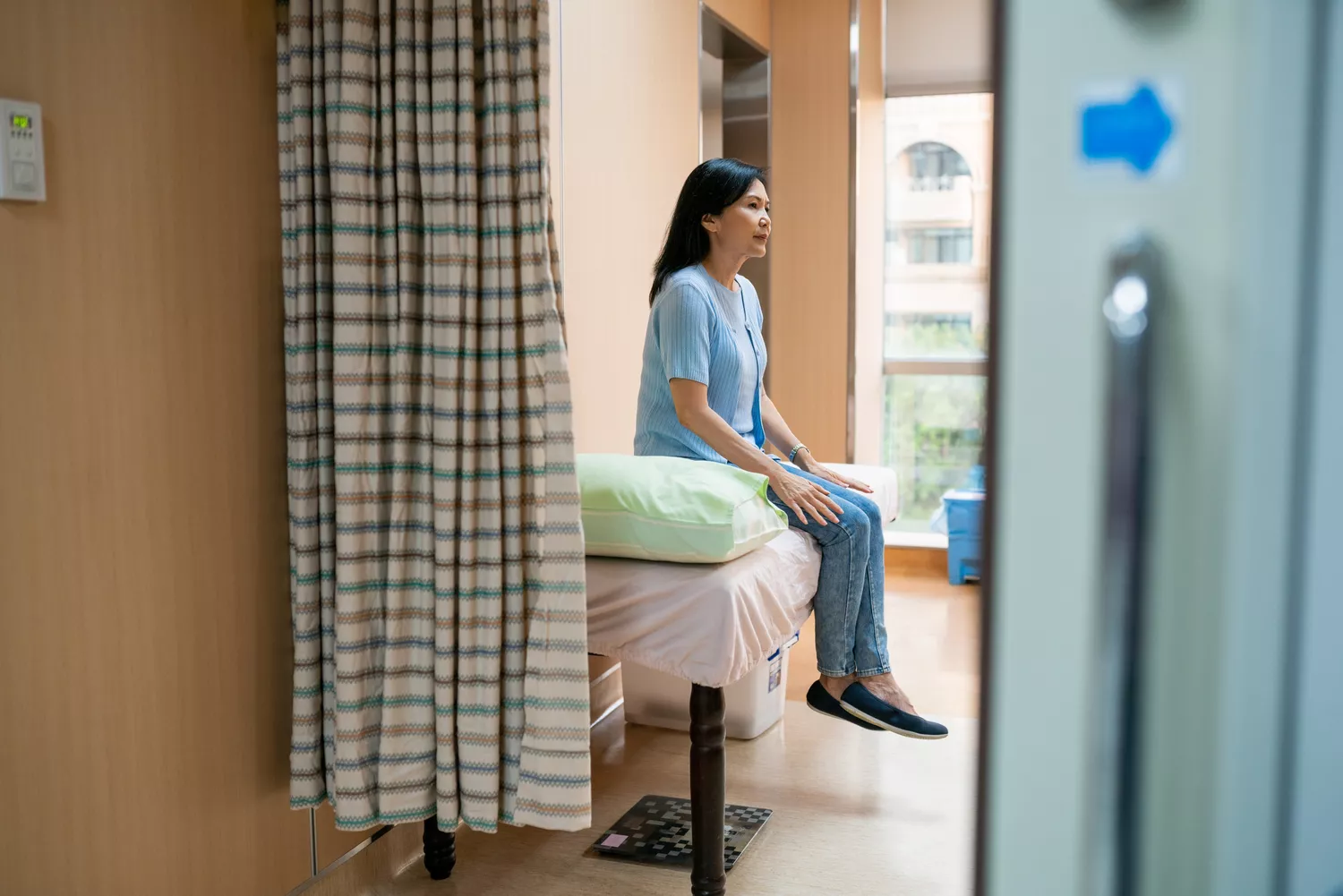Two Different Diseases Related to the Uterus
By Jennifer Welsh
- Endometriosis
- Symptoms
- Causes
- Diagnosis
- Staging
- Treatment
- Frequently Asked Questions
Endometriosis is a condition caused when tissue that resembles the lining of the uterus (womb) grows outside the uterus, where it should not be. This condition is noncancerous and not deadly, but it can significantly affect your quality of life.1
Endometriosis is not cancer and does not seem to increase the risk of uterine cancer. Some studies have suggested that about 2% of people with endometriosis develop uterine cancer. This is similar to the rate of uterine cancer in the broader female population, which is between 1% and 3%.2
Rare ovarian cancers, including clear cell ovarian cancer and endometrioid ovarian cancer, are more common in people with endometriosis. Still, because these cancers are so rare, these differences aren’t enough to raise the cancer risk of people with endometriosis substantially higher than those without endometriosis.2
:max_bytes(150000):strip_icc():format(webp)/VWH-GettyImages-1179734060-05673cb67d4646e48eb12706af4d3f00.jpg)
This article will clear up the confusion about endometriosis being cancer and whether endometriosis increases cancer risk. Below are the definitions and differences between endometriosis, endometrial cancer, and endometritis.
Endometriosis Is Not Endometrial Cancer
Both endometriosis and endometrial cancer develop from the tissue that lines the inside of the uterus. The uterus is a small, pear-shaped female reproductive organ with a central cavity. This cavity holds a fetus during pregnancy. At the bottom of the cavity is the cervix, which leads into the vagina.3
What Is Endometriosis?
Endometriosis is a noncancerous (benign) condition that causes tissue that resembles the uterus lining to grow in the abdomen. It can cause severe pelvic pain, irregular menstrual bleeding, gastrointestinal (related to the digestive tract) symptoms, and infertility.1 The tissue can spread into the abdomen but also in more distant places, such as the lungs, skin, or brain.
The outer layer of the uterus, called the myometrium, is made of muscle. The inner layer is the endometrium. When there is no fetus in the uterus, and it is not being controlled with hormonal or physical birth control, the endometrium grows thicker in response to hormones.
Once every 28 days or so, this lining sheds if an embryo hasn’t implanted. The result is a menstrual period. At this time each month, blood and endometrial tissue exit the uterus through the cervix and into the vagina.
Endometriosis is when the cells lining the uterus’s central cavity grow outside the uterus. Every month when hormones make these cells grow and shed, they cause pain, inflammation, and other symptoms. Though it spreads outside the uterus, endometriosis is not cancerous and is not the same as endometrial cancer.4
Endometrial cancer is when cells that line the inside of the uterus undergo changes and start growing. These cells divide uncontrollably, form balls of cells called tumors, and spread to other parts of the uterus and body.3
Another medical condition that can develop in the uterus is endometritis. Endometritis is when the uterus lining becomes inflamed or irritated, usually due to an infection.
Endometritis can develop after an endometrial biopsy (removing a sample to analyze in the lab), which may be done to diagnose endometrial cancer or endometriosis. Otherwise, it is unrelated to endometrial cancer or endometriosis.5
Common Symptoms of Endometriosis and Endometrial Cancer
Endometriosis and endometrial cancer have a few common symptoms, but there are areas in which they differ, as well.
| Symptoms of Endometriosis and Endometrial Cancer | ||
|---|---|---|
| Symptom | Endometriosis4 | Endometrial Cancer6 |
| Unusual vaginal bleeding, spotting, or other discharge | Yes | Yes |
| Pelvic pain | Yes | Yes |
| An abdominal mass | No | Yes |
| Weight loss | No | Yes |
| Infertility | Yes | No |
| Stomach (digestive) problems | Yes | No |
Similarities and differences in symptoms between endometriosis and endometrial cancer
Symptom Similarities
Pain is a common symptom of both endometriosis and endometrial cancer, but the types of pain and when they occur differ. Pain-related symptoms of endometriosis can include:4
- Excruciating menstrual cramps: The pain may get worse over time.
- Chronic (long-term) pain in the lower back and pelvis
- Pain during or after sex: This “deep” pain is different from other pain during sexual intercourse, often felt at the entrance to the vagina when penetration begins.
- Intestinal pain
- Painful bowel movements
- Pain when urinating during menstrual periods.
People with endometrial cancer typically report more generic pelvic pain that doesn’t change with the menstrual cycle.6
Another common symptom of endometriosis and endometrial cancer is unusual discharge, including bleeding and spotting. About 90% of people with endometrial cancer report abnormal vaginal bleeding.6 People with endometrial cancer may have:
- A change in their periods
- Bleeding between periods
- Bleeding after menopause
Bleeding or spotting between menstrual periods is also a common symptom of endometriosis.
What Does Endometriosis Feel Like?
Symptom Differences
Symptoms of endometriosis, like pain and bleeding, are not necessarily related to the stage of the disease. But stage 4 endometriosis is severe and more likely to impact fertility (the ability to get pregnant).7
Intestinal distress that develops during menstrual periods is another common symptom of endometriosis. This can include:
- Diarrhea
- Constipation
- Bloating
- Nausea
Symptoms of endometrial cancer include unexplained weight loss and the presence of a mass in the abdomen, especially when the tumor is more advanced.
Causes
There are no clear causes for most cases of either endometriosis or endometrial cancer. Hormone-related treatments and hormone imbalances impact your risk for both of these conditions, but many other risk factors are different.
Endometriosis
There is no single risk factor that researchers believe directly causes endometriosis. There are a few theories about what leads to this disease, which include:4
- Hormones: Most endometriosis risk factors are linked to hormones that regulate reproduction, including estrogen. Unbalanced hormones may be at play in the development of this disease.
- Retrograde menstrual flow: When the uterus lining sheds during your period, a retrograde flow means the blood and tissue travel back into the fallopian tubes and the pelvis.
- Genetic factors: Inherited genetic differences could increase your risk of developing endometriosis.
- Immune system abnormalities: Endometriosis may develop when the immune system fails to find and destroy endometrial tissue growing outside the uterus.
- Surgery: During surgery on the uterus, tissue can be picked up and moved by mistake.
How Do Endometriosis Symptoms Feel?
Endometrial Cancer
Researchers haven’t found any specific causes that lead to endometrial cancer. The following risk factors seem to increase your risk of developing it:8
- Having excess weight: Unhealthy diet, lack of exercise, excess weight, and type 2 diabetes are all risk factors for endometrial cancer.
- Factors affecting hormone levels: Drugs like estrogen after menopause, birth control pills, or tamoxifen affect your hormone levels. Other factors of this type include the lifetime number of menstrual cycles or pregnancies and if you’ve had ovarian tumors, polycystic ovary syndrome, or an intrauterine device (IUD).
- Age: As with most cancers, the risk of endometrial cancer increases as you age.
- Family history: Having close relatives with endometrial or colorectal cancer increases your risk of developing it.
- Genetic syndromes: Hereditary nonpolyposis (without polyps) colon cancer syndrome (Lynch syndrome) increases your risk of developing endometrial cancer.
- Personal history: Personal history may include having breast or ovarian cancer, a hormonal imbalance called endometrial hyperplasia, or radiation treatments to the pelvis.
What Is Endometrial Cancer?
Diagnosis
It may take years for a person to get a diagnosis of endometriosis. The average time between the onset of symptoms and diagnosis of endometriosis is about four to 11 years, according to a 2019 review in the American Journal of Obstetrics and Gynecology.9
Given that these diseases have some of the same symptoms, your healthcare provider may try to determine the source of your pain or bleeding. Pelvic pain and digestive symptoms may also be due to painful bladder syndrome, irritable bowel syndrome (IBS), or fibromyalgia.
Stage 4 Endometriosis
Getting a diagnosis of endometriosis is problematic, given it can be challenging to confirm the spread of endometrial tissue.4 Diagnostic testing may include:
- A pelvic exam to look for endometriosis cysts and scars
- Imaging with ultrasound or magnetic resonance imaging (MRI) to look for signs of endometriosis internally
- Testing how your body responds to hormonal medicine, such as birth control and gonadotropin-releasing hormone (GnHR) agonists
- Surgery to examine and remove endometriosis tissue from your pelvic area
Surgery is the only way to truly confirm endometriosis. A surgeon will be able to see the growths and take samples to study under a microscope. It is also the only way to stage endometriosis, as the staging process requires a visual examination of adhesions and growths.
Stage 4 endometriosis is diagnosed if the person has severe growths deep into other tissues, ovarian cysts (fluid-filled sacs on the surface of the ovary), and large swaths of scar tissue sticking organs together. The growths may be found in the abdomen or in distant locations, including the lungs, skin, or brain.
How Endometriosis Is Diagnosed
Endometrial Cancer
Tests to diagnose endometrial cancer may include:10
- Medical history, physical exam, and pelvic exam
- Examination of the internal reproductive organs (ovaries, uterus, fallopian tubes) through a pelvic, transvaginal, or saline infusion ultrasound
- Taking endometrial tissue samples through an endometrial biopsy or dilation and curettage (D&C) to test for the presence of cancer and genetic mutations
- Imaging tests to check for spread to other areas of the body
- Possible examinations inside the bladder via cystoscopy and the inside the rectum via proctoscopy
- Blood tests to analyze your white blood cells and test for the tumor marker CA-125
How Endometrial Cancer Is Diagnosed
Staging of Diseases
Both endometriosis and endometrial cancer are staged—meaning they are put on a scale of severity. But stage 4 endometriosis is not the same as stage 4 endometrial cancer. They are staged using different systems; these stages are defined differently and have different prognoses.
Stage IV Endometriosis
Healthcare providers stage endometriosis using the American Society of Reproductive Medicine (ASRM) points system. This system assigns points based on specific characteristics of the endometriosis lesions, as seen during surgery. But the stage doesn’t necessarily correlate with symptoms or how much the disease affects the person.7
The staging process is based on a visual examination of the abdomen during surgery, including the size of the lesions and scar tissue. Lesions are also classified as either deep or superficial. They are given a point value based on the system, and these points are added to determine the disease’s total stage, such that:
- A deep lesion on the ovary larger than 3 centimeters (cm) across scores 20 points.
- Dense scarring on the ovary or blockage of the fallopian tubes scores 16 points.
- A complete cul-de-sac obliteration (when the rectum is stuck with scar tissue to the back of the uterus and cervix) scores 40 points and is automatically classified as severe, stage 4 endometriosis.
The stages of endometriosis based on this point system are:
- Stage 1 or minimal disease: Scoring fewer than 5 points
- Stage 2 or mild disease: Scoring 6–15 points
- Stage 3 or moderate disease: Scoring 16–40 points
- Stage 4 or severe disease: Scoring more than 40 points
Stage 4 endometriosis, or severe disease, typically has many deep growths of endometriosis plaques, large cysts on one or both ovaries, and many dense adhesions. There is usually also extensive scar tissue in the abdomen and signs of inflammation.
Endometriosis Stages and What They Mean
Endometrial Cancer
The staging of endometrial cancer is defined by how large the tumor is, how far it has spread within the uterus, and if it has spread to lymph nodes or other organs, as follows:11
- Stage 1 endometrial cancer is contained inside the body of the uterus.
- Stage 2 endometrial cancer has spread to the tissue that connects the uterus to the cervix.
- Stage 3 endometrial cancer has spread to the outer surface of the uterus or the lymph nodes in the pelvis, fallopian tubes, ovaries, or vagina.
- Stage 4 endometrial cancer has spread to the rectum, bladder, groin lymph nodes, abdomen, or distant organs like the lungs, liver, or bones.
Treatment
Because they are different diseases, the treatments for endometriosis and endometrial cancer are very different.
Stage 4 Endometriosis
Treatments can help reduce the symptoms and problems caused by stage 4 endometriosis. Treatment includes:4
- A birth control pill, shot, or intrauterine device: The hormone progesterone (natural) and progestin (a synthetic version) in these birth control options can improve endometriosis symptoms.12
- Medicine called GnRH agonists: These drugs send the body into temporary menopause, stopping the growth of endometriosis. The prescription endometriosis medications Myfembree (relugolix, estradiol, and norethindrone acetate) and Orilissa (elagolix) are GnRH agonists designed to treat pain from endometriosis during periods, between periods, and during sex.13
- Surgery: A surgeon locates and removes areas of endometriosis, reducing severe pain and improving fertility. More extensive surgeries, including hysterectomy (removal of the uterus) and removing ovaries and fallopian tubes, are reserved for the most extreme cases of endometriosis.
- Over-the-counter pain medicine: These include Advil or Motrin (ibuprofen) or Aleve (naproxen).
- Prescription pain medication: Prescription pain medications like opioids and benzodiazepine can reduce the pain from moderate to severe, stage 4 endometriosis.14
Recurrence of Pain
There is no cure for endometriosis. Surgery can relieve the pain of endometriosis, but this relief is temporary. Within two years of surgery, 40%–80% of people with endometriosis are in pain again.15
How Endometriosis Is Treated
Stage 4 Endometrial Cancer
Treatment for stage 4 endometrial cancer is aggressive. Stage 4 endometrial cancer is deadly without treatment.
Surgery to remove the uterus, ovaries, and fallopian tubes is typically followed by radiation therapy and hormone therapy (reduces hormones or blocks their action) if the tumor is hormone receptor-positive (meaning the tumor cells bind hormones to their surface).16 A combination of chemotherapy drugs follows these treatments.
Targeted therapies (which attack tumors with specific characteristics), immunotherapy (uses immune system processes or specialized immune proteins), or new treatments being tested in clinical trials are treatment options for Stage 4 endometrial cancer, especially if it comes back after the first round of treatments.
How Endometrial Cancer Is Treated
Summary
Stage 4 endometriosis is not endometrial cancer. The staging of endometriosis indicates how severe the disease is, but it does not mean it’s more likely to develop into or cause cancer. Stage 4 endometriosis is a painful disease that has caused uterine tissue to grow outside the uterus, creating scar tissue.
Endometriosis can cause digestive symptoms, infertility, and pelvic pain that get worse when you’re menstruating and with time. Treatment for endometriosis focuses on treating the symptoms—relieving the pain through medications, surgery, and other treatment options.
Endometrial cancer can also cause pelvic pain, irregular bleeding or discharge. It can be felt as a lump or mass in the abdomen and can lead to unexplained weight loss.
Endometrial cancer is deadly, and the treatment is focused on removing as much of the cancer as possible and killing any remaining cancer cells with radiation, hormone therapy, chemotherapy, immunotherapy, and targeted therapies.
FREQUENTLY ASKED QUESTIONS
- What cancers are more common in people with endometriosis?Rare ovarian cancers, including clear cell ovarian cancer and endometrioid ovarian cancer, are more common in endometriosis patients. But because these cancers are rare to begin with, these differences aren’t enough to raise the cancer risk of people with endometriosis substantially higher than those without it.2
Learn More: Can Endometriosis Increase Your Risk of Cancer? - Is stage 4 endometrial cancer curable?Stage 4 endometrial cancer is not curable. It has often spread too far for surgery to remove all the cancer. Other therapies, like chemotherapy, radiation, hormone therapy, targeted therapy, and immunotherapies, may put the disease into remission.16Learn More: What Is Stage 4 Cancer?
- What is the survival rate of stage 4 endometrial cancer?About 20% of people diagnosed with “distant” endometrial cancer between 2011 and 2017 were alive five years later. Distant is when cancer has spread to far areas of the body and is on par with a stage 4 diagnosis.17
- reference<https://www.verywellhealth.com/endometriosis-stage-four-vs-cancer-6454993



